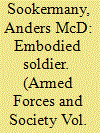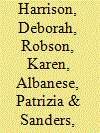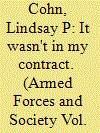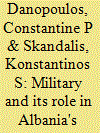|
|
|
Sort Order |
|
|
|
Items / Page
|
|
|
|
|
|
|
| Srl | Item |
| 1 |
ID:
106439


|
|
|
|
|
| Publication |
2011.
|
| Summary/Abstract |
The transformation of the Armed Forces is changing our understanding of what good soldiering skills are. The ongoing (post) modernization process aims to develop military communities of practice that are ready, willing, and able to serve and fight anyone, anywhere, and anytime on a regular basis. As a consequence, many Western countries such as Norway are witnessing a radical shift from an invasion defense-based concept grounded on conscription toward a more flexible expeditionary force-based defense concept that emphasizes professionalism. As such, it follows the typology of a change from a modern to a postmodern military. The understanding of the soldier as a human body is of great interest in this context since it is the individual (the soldier) who is to bring this transformation to life through his or her military (bodily) actions/skills within the military community of practice of which he or she is a member. This study describes and interprets the consequences of the ongoing military transformation with regard to the view of the human body so as to better understand the epistemological foundation for good soldiering skills.
|
|
|
|
|
|
|
|
|
|
|
|
|
|
|
|
| 2 |
ID:
106443


|
|
|
|
|
| Publication |
2011.
|
| Summary/Abstract |
Preliminary results of our survey of 1066 adolescent members of a Canadian Forces (CF) community, comparing the mental health and well-being of CF and civilian youth in a secondary school adjacent to an army base, yielded surprising results. The data were collected in 2008 with an instrument that replicated parts of the National Longitudinal Survey of Children and Youth (NLSCY). Our findings suggested that there are few statistically significant differences between CF and civilian youth on mental health and well-being measures. On the other hand, both the CF and civilian youth scored lower on crucial health and well-being measures than their peers in the national NLSCY sample. This research note attempts to explain these complementary findings, using data from follow-up semi-structured interviews we conducted in 2009/10 with 60 of the CF adolescents. It also considers the possibility of a ''spillover effect'' of military life stressors on civilian youth.
|
|
|
|
|
|
|
|
|
|
|
|
|
|
|
|
| 3 |
ID:
106434


|
|
|
|
|
| Publication |
2011.
|
| Summary/Abstract |
An increase in the use of private military and security contractors over the last two decades has sparked a debate over whether their employment enhances or detracts from government control of its security agents. Although there is a rich literature on civilian control of military agents, there is still disagreement on the operationalization of control, and there has been little attempt to apply these theories to private actors. This article contributes to both discussions by offering a synthesis of theories of control and comparing features specific to public versus private agents that may affect control. The author offers the hypothesis that the principles of democratic governance are likely to be more secure when policy is carried out by public agents.
|
|
|
|
|
|
|
|
|
|
|
|
|
|
|
|
| 4 |
ID:
106437


|
|
|
|
|
| Publication |
2011.
|
| Summary/Abstract |
The Standard Model has become the primary approach to military group cohesion. Yet the key theoretical drivers that explain where the Model came from have not been well articulated. This article addresses that deficiency by presenting those main drivers in past research and the key questions derived from the research that guided development of the Model. Additionally, recent research has brought several potential challenges to the Standard Model, which also have not been well articulated or presented together in one place. This effort addresses those theoretical problems as well as logically deduced challenges, which in all have been labeled by the author as the Horizon Problem, Individual Differences Problem, Roman Road Problem, Reductionist Problem, Life Cycle Problem, Frame Problem, Common Goal Problem, and Action Problem. Some limits to the Standard Model are noted in the process of showing how the Model can accommodate these challenges.
|
|
|
|
|
|
|
|
|
|
|
|
|
|
|
|
| 5 |
ID:
106435


|
|
|
|
|
| Publication |
2011.
|
| Summary/Abstract |
Communist and hermetically sealed Albania entered a process of democratization in the early 1990s. One of the most salient characteristics of democratic governance is to bring and keep the military under the control of the elected authorities. Following a theoretical discussion on the differences between civilian and democratic control, the article dwells on the specifics of the Albanian case. The work identifies, analyzes, and assesses the strategies employed by the first postcommunist government to bring about democratic control over the nation's military. The four strategies included: departization, depoliticization, democratization, and professionalization. The article argues that the government's efforts ended up damaging the military organization to the point that the Albanian army disintegrated and did not and could not heed the President's call to quell the popular uprising in March 1997. The concluding section of the article discusses post-1997 developments and assesses the lessons learned.
|
|
|
|
|
|
|
|
|
|
|
|
|
|
|
|
| 6 |
ID:
106440


|
|
|
|
|
| Publication |
2011.
|
| Summary/Abstract |
The study examines the place of the military in the unprecedented ten-year survival of Nigeria's democracy. Two competing hypotheses are presented. Was democratic stability a product of (1) improvements in democratic governance or (2) characterized with the Nigerian armed forces? Although neither hypothesis can be rejected, military factors appear to provide the strongest explanation.
|
|
|
|
|
|
|
|
|
|
|
|
|
|
|
|
| 7 |
ID:
106441


|
|
|
|
|
| Publication |
2011.
|
| Summary/Abstract |
At their final training session, soldiers at the Israeli Defense Forces (IDF) close-combat instructors' course are faced with an extreme situation. Clad in full protection gear, they must face consecutive opponent and fight until they can fight no more. The training setting presents to the soldiers a dilemma epitomized in the instructor's question ''Do you want to quit?'' The author argues that the question, as well as, the situation as a whole presents the trainees with a paradox that seems at first to be a moral dilemma. However, since the training setting simulates real battle, the question which also has an existential facet, is in fact a pseudo moral dilemma, reversing the order of self-interest and self-regard.
|
|
|
|
|
|
|
|
|
|
|
|
|
|
|
|
| 8 |
ID:
106442


|
|
|
|
|
| Publication |
2011.
|
| Summary/Abstract |
What career information do potential military recruits seek? The Internet increasingly provides a medium for advertising and communication with recruiters and other potential recruits. The authors explored the influence of online information on enlistment decision making. Analysis of recent Army new recruit surveys showed that a sizable proportion of recruits have encountered military advertising or sought recruiting information online. The authors also examined online discussion forums-in which soldiers and prospective soldiers ask questions, trade insights, and vent frustrations-for postings indicating information seeking for enlistment decision making. Potential recruits were most interested in recruiting processes and what to expect from a military lifestyle, seeking opinions and details on job functions, duty stations, and benefits. These findings suggest that potential recruits may seek information online when unable or unwilling to find it from military websites or talking to recruiters.
|
|
|
|
|
|
|
|
|
|
|
|
|
|
|
|
| 9 |
ID:
106436


|
|
|
|
|
| Publication |
2011.
|
| Summary/Abstract |
As a consequence of various causes, numerous children are confronted with parental separation. By following families in the course of military deployments, this study aimed at enhancing knowledge on temporary father-child separation. Data were part of a longitudinal study of military families and were collected among Dutch service members and their partners before, during, and after a deployment to Bosnia or Afghanistan. Results revealed that the great majority of the children adapted quite well to the separation and reunion. Furthermore, the general well-being of the children, the mothers, and the fathers in the mission area was positively related. Unlike separation characteristics, maternal well-being was predictive of children's adjustment in the course of paternal deployment. Hence, the findings underline the importance of helping spouses cope with the absences of service members as it increases the chances that children will also be doing well in the course of parental absence.
|
|
|
|
|
|
|
|
|
|
|
|
|
|
|
|
|
|
|
|
|